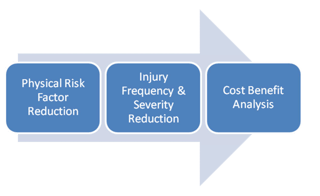Part III- Measuring Long Term Impact
Integrated risk assessments identify and prioritize the physical risk factors that cause musculoskeletal injuries and drive workers compensation costs. Targeted solutions that incorporate three components, solution type, recipient, and delivery method are effective in optimizing the time and resources that a company can focus on injury prevention. But how do you know the program is successful? How can you be confident that your Injury Prevention Program is actually preventing injuries AND saving money?
There are three steps to ensuring that your program is working for you.

STEP 1: The first step is quantifying the reduction in key physical risk factors that were driving injury rates and workers compensation costs. There are many tools that can be used to do this such as quantifying repetition or duty cycle, or even providing surveys to employees following key trainings.
STEP 2: The second step is tracking injury frequency and severity by injury type, body region, and location. Reductions in frequency and˜or cost should lag slightly behind the implementation of solutions.
STEP 3: The third step is to calculate a return on investment for your program. Arguably this is a difficult endeavor but a particularly important one to substantiate future spending on injury prevention programs. A key consideration is the indirect cost savings assumption. This should be conservative, clearly identified and agreed upon by key stakeholders of the program prior to the R˜I being generated.